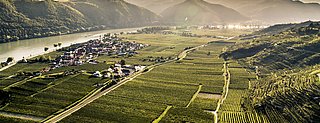
Kreutles
Facts:
- Town:
- Unterloiben
- Size in ha:
- 8,62
- Altitude in m:
- 212 - 230
- Average Slope in %:
- 6
- Max. Slope in %:
- 24
- Insolation in hours per year:
- 2379
- Terraced vineyard:
- No
- Distance to Danube in m:
- 228
- Labour required in h:
- 3.000
- First documentary evidence:
- JF 1786 - 1787
Description
The Kreutles vineyard is the more eastern of the two slope toe locations on the Loibenberg. The name is referring to the former undergrowth that had to be removed to cultivate the area.
Soil Profile Kreutles
The Kreutles vineyard at the foot of the Loibenberg is formed from loess. Loess is a fertile and calcareous glacial sediment that is transported by wind.
Two distinct horizons can be seen in the profile: the upper horizon that is enriched with humus, and the brownish-red loess horizon. This soil has developed from eroded Gföhl gneiss material from the nearby Loibenberg. At the top left of the humus horizon, there is a pebble from a transported glacial Danube riverine terrace, which was also transported down to the Kreutles vineyard by slope erosion on the Loibenberg.
The wines from loess soils are expressive, and depending on the winemaker's signature, they can also reach baroque richness.







